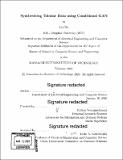| dc.contributor.advisor | Kalyan Veeramachaneni. | en_US |
| dc.contributor.author | Xu, Lei(Electrical and computer scienctist)Massachusetts Institute of Technology. | en_US |
| dc.contributor.other | Massachusetts Institute of Technology. Department of Electrical Engineering and Computer Science. | en_US |
| dc.date.accessioned | 2020-11-03T20:32:18Z | |
| dc.date.available | 2020-11-03T20:32:18Z | |
| dc.date.copyright | 2020 | en_US |
| dc.date.issued | 2020 | en_US |
| dc.identifier.uri | https://hdl.handle.net/1721.1/128349 | |
| dc.description | Thesis: S.M., Massachusetts Institute of Technology, Department of Electrical Engineering and Computer Science, February, 2020 | en_US |
| dc.description | Cataloged from PDF version of thesis. | en_US |
| dc.description | Includes bibliographical references (pages 89-93). | en_US |
| dc.description.abstract | In data science, the ability to model the distribution of rows in tabular data and generate realistic synthetic data enables various important applications including data compression, data disclosure, and privacy-preserving machine learning. However, because tabular data usually contains a mix of discrete and continuous columns, building such a model is a non-trivial task. Continuous columns may have multiple modes, while discrete columns are sometimes imbalanced, making modeling difficult. To address this problem, I took two major steps. (1) I designed SDGym, a thorough benchmark, to compare existing models, identify different properties of tabular data and analyze how these properties challenge different models. Our experimental results show that statistical models, such as Bayesian networks, that are constrained to a fixed family of available distributions cannot model tabular data effectively, especially when both continuous and discrete columns are included. Recently proposed deep generative models are capable of modeling more sophisticated distributions, but cannot outperform Bayesian network models in practice, because the network structure and learning procedure are not optimized for tabular data which may contain non-Gaussian continuous columns and imbalanced discrete columns. (2) To address these problems, I designed CTGAN, which uses a conditional generative adversarial network to address the challenges in modeling tabular data. Because CTGAN uses reversible data transformations and is trained by re-sampling the data, it can address common challenges in synthetic data generation. I evaluated CTGAN on the benchmark and showed that it consistently and significantly outperforms existing statistical and deep learning models. | en_US |
| dc.description.statementofresponsibility | by Lei Xu. | en_US |
| dc.format.extent | 93 pages | en_US |
| dc.language.iso | eng | en_US |
| dc.publisher | Massachusetts Institute of Technology | en_US |
| dc.rights | MIT theses may be protected by copyright. Please reuse MIT thesis content according to the MIT Libraries Permissions Policy, which is available through the URL provided. | en_US |
| dc.rights.uri | http://dspace.mit.edu/handle/1721.1/7582 | en_US |
| dc.subject | Electrical Engineering and Computer Science. | en_US |
| dc.title | Synthesizing tabular data using conditional GAN | en_US |
| dc.type | Thesis | en_US |
| dc.description.degree | S.M. | en_US |
| dc.contributor.department | Massachusetts Institute of Technology. Department of Electrical Engineering and Computer Science | en_US |
| dc.identifier.oclc | 1202001437 | en_US |
| dc.description.collection | S.M. Massachusetts Institute of Technology, Department of Electrical Engineering and Computer Science | en_US |
| dspace.imported | 2020-11-03T20:32:17Z | en_US |
| mit.thesis.degree | Master | en_US |
| mit.thesis.department | EECS | en_US |
